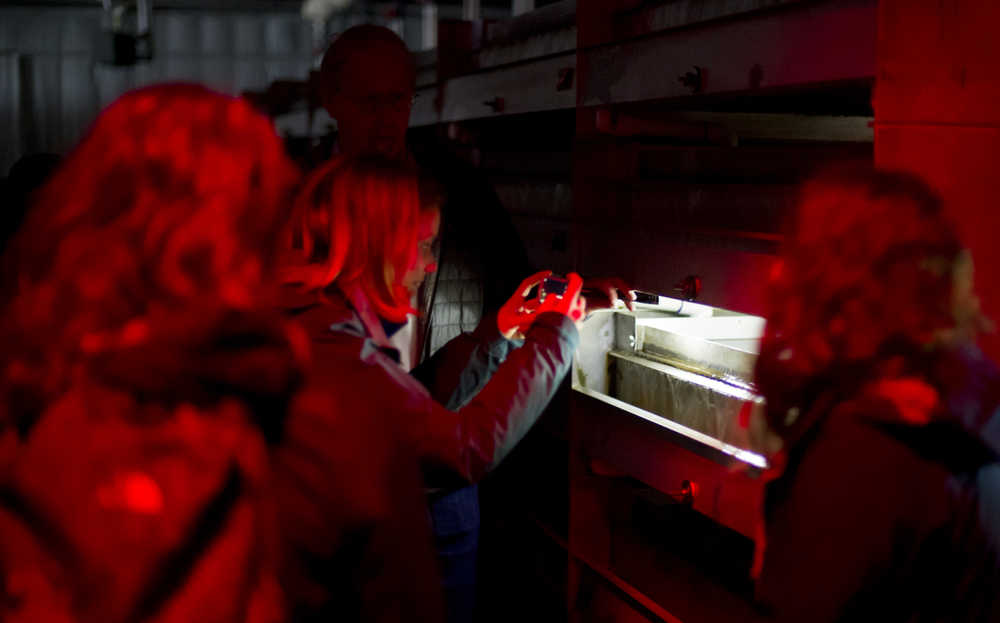Alaska’s fishing fleet may be graying, but there isn’t much gray at the sixth annual Alaska Young Fishermen’s Summit, hosted by the Alaska Sea Grant Marine Advisory Program and held this week in Juneau.
Different organizers would likely give different answers as to the genesis of the summit, said Petersburg Sea Grant agent Sunny Rice, but for her, it comes down to empowering the young people that are the fleet’s future.
“There are big changes going on, big decisions being made at Board of Fish, and at the North Pacific Fishery Management Council, and the young fishermen are not necessarily the ones that have the time and the money to go to those meetings, but they’re the ones that those decisions are going to impact for a long time. So I wanted to… give them a chance to have a voice,” Rice said.
According to the Alaska Marine Conservation Council, which calls the “graying of the fleet” “a pressing concern for the state of Alaska and its coastal communities,” the average age of an Alaska fishery permit holder in 2013 was 49.7 years old — 10 years older than the average age in 1980. Now, the council says, only 17.3 percent of permit holders are under 40; in 1980, it was 38.5 percent.
The council, the University of Alaska Fairbanks and the Alaska Sea Grant program are working on a project examining the problem and figuring out ways to fix it.
A “young fisherman,” Rice said, can be anyone that has committed to commercial fishing as a career and wants to learn more, but attendees at the summit tend to be under 40. (The organization’s sponsors and speakers pay young fishermen’s way to the summit.) This week, they met other young fishermen, legislators, biologists, managers, bankers and people with other roles related to fishing. They also talked about their concerns for the future of Alaska’s ocean and their living on it.
Another big aspect to the summit is running a small business, and all that fishermen have to do on land. Both Shawn Kamkahpak of the F/V Far Away, a gillnetter out of Togiak, and Darren Platt of the F/V Agnes Sabine, a seiner out of Kodiak, were looking for information and tips on business management.
Steven Johnson, who was born in Sitka and now lives in Wrangell, came for information and for contacts. His background is in trolling, though now he owns a tender — the F/V Sally N.
“I have groups of people that I work with, but it’s nice to expand that pool of knowledge. There’s a lot to know,” he said. “You never can have too many people to call and ask a question.”
By Wednesday at noon, he’d already found Chris Trainer’s talk on “insurance tools to reduce risk” more informative than lots of other advice he’s received, he said.
Bristol Bay F/V Garfield gillnetter Mickey Sharp, who got his start gillnetting with his grandfather and now fishes with his 9-year-old son, has been to the summit twice before. His main concerns are fish prices and the weather. Both have been changing, and not for the better, he said.
Prices last season in Bristol Bay were about 50 cents per pound of sockeye.
“Fifty cents a pound for reds seems outrageous,” said Alaska Department of Fish and Game Commissioner Sam Cotten in response to a fisherman’s question. “From a fisherman’s perspective, I certainly agree.”
He talked about reasons for the price and a few of the options the government has, one of which is allowing foreign processors in if American processors don’t have the capacity to process and buy the season’s fish.
At Douglas Island Pink and Chum on Wednesday afternoon, Alaska Sea Grant agent Torie Baker moderated a panel about environmental concerns like algae blooms, ocean acidification, bycatch and king salmon, which Forrest Bowers, deputy director of commercial fishing at ADF&G, said seems to be improving in the state.
“We think that’s starting to shift a little bit,” he said. “We may be entering a period of improved (king salmon) production in Alaska. We’re starting to get a feeling.”
Gov. Bill Walker addressed the group on Wednesday, telling them he’s “just thrilled to see this program.”
“There are not enough young fishermen,” he said. “Our oceans are so abundant with opportunity. Our job is to make sure that those opportunities are connected with you, with Alaskans.”
Thursday, fishermen went to the Legislature, met with the House Fisheries Committee, and learned about the state Board of Fish; Friday they observed the International Pacific Halibut Commission, which is meeting in Juneau this week and approved catch limits and regulations.
Attendees also broke into small groups to talk about big issues, including things like ocean acidification, fish prices and transboundary mines, Rice said.
“It’s the only time that… someone from Bristol Bay is going to be sitting next to someone from Southeast Alaska,” she said. “And maybe they have issues they have in common, and they can learn things from each other.”
“I think it’s really important for young fishermen to have a political voice,” said Sitka fisherman Sophie Nethercut, who deckhands on a troller out of Sitka, and was also at the summit with the Sitka Conservation Society.
“We’re dealing with huge issues, including transboundary mines and ocean acidification… we want to work with other young fishermen to build a coalition.”
Contact Juneau Empire Outdoors editor Mary Catharine Martin at maryc.martin@juneauempire.com.

